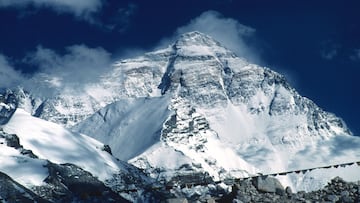This is the reason there aren’t any mountains over 30,000 feet
Pressure, tectonics, and erosion define the planet's natural ceiling.

Mount Everest stands 8,849 metres tall and continues to grow by a few millimetres each year. A study conducted in the 1980s suggested that the mountain could theoretically reach a height of 45,000 metres, but in reality, such a figure is impossible on Earth.
Haakon Fossen, a professor of geology at the University of Bergen, told ScienceNorway that “mountains cannot be much higher than they are now.” The reason, he explained, is quite simple: above an average altitude of 5,000 metres, pressure becomes so intense that the rock behaves plastically at depth. In other words, it can deform and even flow.
The Himalayas formed around 50 million years ago, the result of a collision between two giant tectonic plates. “It’s easier to create high mountains during the first 15 to 20 million years of a collision,” said Fossen. After that period, the forces reach equilibrium, and the greater the height, the greater the pressure.
Drone footage from above Mount Everest, the highest peak of the world.
— Wonder of Science (@wonderofscience) October 11, 2025
📽: DJIpic.twitter.com/U7MxTc8D9j
Fossen likens the process to “yeast dough rising on a table.” This is why most Himalayan peaks rise to about 5,000 metres. Everest and K2 are rare exceptions, and there are several theories that attempt to explain how such towering summits came to exist.
Hannah Pomella, from the Institute of Geology at the University of Innsbruck, explained that “tectonics generates height.” Height itself, in turn, influences the formation of even higher mountains. “Tectonics doesn’t move quickly enough to stop glaciers from eroding the mountain from one side,” she added.
It isn’t just glaciers that wear down the summits but also erosion caused by wind and weather. “Basically, it’s the fact that we have water—whether in the form of ice, snow, or simply rain—that really limits the growth of mountains,” Rachel Headley told the BBC.
On October 15, 2025, Jim Morrison completed the first ski descent of Mount Everest’s Hornbein Couloir—solving what elite ski mountaineers worldwide called "the last great problem." pic.twitter.com/iXe2l1MMl6
— National Geographic (@NatGeo) October 27, 2025
Related stories
“At a certain point, the mountain also becomes so steep that it grows unstable and collapses,” added Aurora Elmore, a geology expert, in another interview with the BBC.
Get your game on! Whether you’re into NFL touchdowns, NBA buzzer-beaters, world-class soccer goals, or MLB home runs, our app has it all. Dive into live coverage, expert insights, breaking news, exclusive videos, and more – plus, stay updated on the latest in current affairs and entertainment. Download now for all-access coverage, right at your fingertips – anytime, anywhere.



Complete your personal details to comment